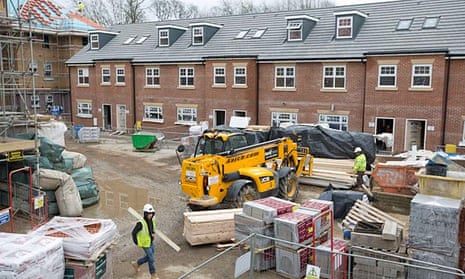David Cameron’s pledge to help generation rent buy a “roof of their own” will help only higher earners, and could have a negative impact on social mobility, housing experts have warned.
In his speech to his party’s annual conference, the prime minister confirmed that planning laws would be changed to allow developers to offer starter homes priced at 20% below market rate, instead of building affordable homes to rent.
He said the policy would create 200,000 homes by 2020 for buyers aged under 40, and mean a shift “from generation rent to generation buy”.
However, the housing charity Shelter said the policy would create homes that were out of reach for families on average earnings in 58% of the country by 2020.
Its chief executive, Campbell Robb, said: “You don’t solve an affordability crisis by getting rid of the few affordable homes we’re building, yet that’s exactly what this policy will do.”
Robb said the homes would “too often only be ‘affordable’ for higher earners”.
He added: “There’s nothing wrong with helping people on to the property ladder, but the government has to invest in genuinely affordable homes to buy and rent for all of those on ordinary incomes who are bearing the brunt of this crisis.”
The consultancy firm KPMG warned that the policy could lead to “divided communities, as builders opted to create homes to sell rather than rent for financial reasons. The firm’s head of housing, Jan Crosby, said it was a “worrying time” for those who were a long way off being able to buy a home and needed an affordable, secure rental system.
Under the policy, Crosby warned “We will see a decrease in mixed-tenure developments, and an increasingly divided community defined by whether they are an “owner” or a “renter”, something which will stymie the social mobility the government has said it is keen to see.
“What we need is to be able to build affordable homes across all tenures – the fact is that the UK public will never be 100% homeowners.”
The campaign group Generation Rent said the change would do nothing for renters who were struggling. Dan Wilson Craw, policy manager at the group, said that while 200,000 “relatively well-off” households would get to buy a home, 5m more would “remain stuck in private rented housing, paying out half of their income to their landlord”.
“If David Cameron prioritised building social housing instead, he would finally begin to fix the affordability crisis. With lower demand for private rentals, rents would fall, and private renters could start saving for that home of their own,” he added.
The National Housing Federation, which represents housing associations that provide affordable homes for rent and for sale through shared ownership schemes said it was encouraging to see the government focusing on supply, but it had concerns that the plans could lead to fewer homes being built for rent.
Its director of policy, Ruth Davison, said: “The government is quite right to be focusing on housebuilding – we have simply not built enough homes of all types for 40 years now – and although many aspire to home ownership we must not forget those who dream of a decent affordable rented home to call their own.”
The National Association of Estate Agents said the pledge of 200,000 new homes was not enough to lift the country out of the housing crisis, and questioned what would be meant by “affordable”.
“We first heard this pledge in Cameron’s pre-election campaign, and we still support the sentiment,” said the NAEA’s managing director, Mark Hayward.
“However, other initiatives such as the Help to Buy scheme still remains in place and it boils down to the fact that we are still waiting to see new homes being built; and whilst we wait capacity remains stretched, infrastructure is not in place and house prices continue to grow.”
One London estate agency said the plans needed to be “more ambitious” to help buyers in London.
Andrew Bridges, managing director of Stirling Ackroyd, said: Capping this policy at homes worth £450,000 in London is clearly designed as a way of targeting the policy towards those at the bottom of the property ladder.
“But it isn’t in proportion to London’s reality. Our own figures show the average one-bed flat in the London area is now worth £437,000 – which may well reach the new limit by the time this plan comes into action. Already, 38% of postal districts around Greater London have average prices for a one-bed flat above £450,000.”
Housebuilders welcomed the announcement, with the Home Builders Federation saying it would make more sites viable for new housing.
Stewart Baseley, the executive chairman of the Home Builders Federation, said: “Over the past 25 years, as building new homes has become ever more costly and complex, output has fallen and the housing ladder has slipped further out of reach for many.
“Greater flexibility in the way affordable housing is provided should not only speed up the process of securing an implementable planning permission but also make more sites viable for new housing. This will in turn increase availability of homes of all types and help address the chronic shortage that has been allowed to develop,” he added.

Comments (…)
Sign in or create your Guardian account to join the discussion